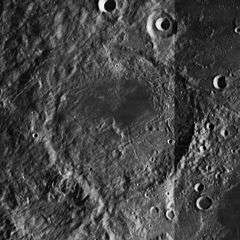Riccioli (crater)
Riccioli is a large lunar impact crater located near the western limb of the Moon. It lies just to the northwest of the even larger and more prominent crater Grimaldi. To the southwest are the craters Hartwig and Schlüter that lie on the northeastern edge of Montes Cordillera, the ring-shaped range that surrounds Mare Orientale. Due to its location, Riccioli appears strongly foreshortened from the earth and is viewed almost from the side.
 Mosaic of Lunar Orbiter 4 images | |
| Coordinates | 3.0°S 74.3°W |
|---|---|
| Diameter | 146 km |
| Depth | 2.3 km |
| Colongitude | 75° at sunrise |
| Eponym | Giovanni B. Riccioli |
Riccioli is older than the Orientale basin to the southwest because the ejecta from the impact that created the Orientale basin overlies the crater. This debris lies in ridges that regionally trend northeast-southwest, but trend in a direction parallel to Riccioli's northeast wall in that part of the crater. A system of rilles named the Rimae Riccioli lies across the interior, and crosscut the ejecta ridges. In the northern half of the interior, the dark covering of lava that resurfaced the floor is visible, and apparently covers some of the ejecta ridges and floods some of the rilles.
The crater is named after Giovanni Battista Riccioli, an Italian Jesuit astronomer who introduced the system of lunar nomenclature that is still in use today. He was also the first person to measure the rate of acceleration of a freely falling body.
Satellite craters
By convention these features are identified on lunar maps by placing the letter on the side of the crater midpoint that is closest to Riccioli.
| Riccioli | Latitude | Longitude | Diameter |
|---|---|---|---|
| C | 0.6° N | 73.0° W | 31 km |
| CA | 0.6° N | 73.0° W | 14 km |
| F | 8.6° S | 73.9° W | 28 km |
| G | 1.3° S | 71.0° W | 15 km |
| H | 1.1° N | 74.9° W | 18 km |
| K | 2.2° S | 77.5° W | 43 km |
| U | 5.7° S | 72.8° W | 9 km |
| Y | 3.0° S | 73.2° W | 7 km |
References
- Andersson, L. E.; Whitaker, E. A. (1982). NASA Catalogue of Lunar Nomenclature. NASA RP-1097.CS1 maint: ref=harv (link)
- Blue, Jennifer (July 25, 2007). "Gazetteer of Planetary Nomenclature". USGS. Retrieved 2007-08-05.CS1 maint: ref=harv (link)
- Bussey, B.; Spudis, P. (2004). The Clementine Atlas of the Moon. New York: Cambridge University Press. ISBN 978-0-521-81528-4.CS1 maint: ref=harv (link)
- Cocks, Elijah E.; Cocks, Josiah C. (1995). Who's Who on the Moon: A Biographical Dictionary of Lunar Nomenclature. Tudor Publishers. ISBN 978-0-936389-27-1.CS1 maint: ref=harv (link)
- McDowell, Jonathan (July 15, 2007). "Lunar Nomenclature". Jonathan's Space Report. Retrieved 2007-10-24.CS1 maint: ref=harv (link)
- Menzel, D. H.; Minnaert, M.; Levin, B.; Dollfus, A.; Bell, B. (1971). "Report on Lunar Nomenclature by the Working Group of Commission 17 of the IAU". Space Science Reviews. 12 (2): 136–186. Bibcode:1971SSRv...12..136M. doi:10.1007/BF00171763.CS1 maint: ref=harv (link)
- Moore, Patrick (2001). On the Moon. Sterling Publishing Co. ISBN 978-0-304-35469-6.CS1 maint: ref=harv (link)
- Price, Fred W. (1988). The Moon Observer's Handbook. Cambridge University Press. ISBN 978-0-521-33500-3.CS1 maint: ref=harv (link)
- Rükl, Antonín (1990). Atlas of the Moon. Kalmbach Books. ISBN 978-0-913135-17-4.CS1 maint: ref=harv (link)
- Webb, Rev. T. W. (1962). Celestial Objects for Common Telescopes (6th revised ed.). Dover. ISBN 978-0-486-20917-3.CS1 maint: ref=harv (link)
- Whitaker, Ewen A. (1999). Mapping and Naming the Moon. Cambridge University Press. ISBN 978-0-521-62248-6.CS1 maint: ref=harv (link)
- Wlasuk, Peter T. (2000). Observing the Moon. Springer. ISBN 978-1-85233-193-1.CS1 maint: ref=harv (link)
External Links
- Riccioli Crater: Cracked, Melted, and Draped, LROC, Posted by Jim Bell on February 04, 2010.